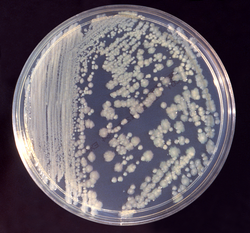Biology:Enterobacter cloacae
| Enterobacter cloacae | |
|---|---|

| |
| Enterobacter cloacae on tryptic soy agar | |
| Scientific classification | |
| Domain: | Bacteria |
| Phylum: | Pseudomonadota |
| Class: | Gammaproteobacteria |
| Order: | Enterobacterales |
| Family: | Enterobacteriaceae |
| Genus: | Enterobacter |
| Species: | E. cloacae
|
| Binomial name | |
| Enterobacter cloacae (Jordan 1890)
Hormaeche and Edwards 1960 | |
| Subspecies | |
|
Aerobacter cloacae (Jordan 1890) Hormaeche and Edwards 1958 | |
Enterobacter cloacae is a clinically significant Gram-negative, facultatively-anaerobic, rod-shaped bacterium.
Microbiology
In microbiology laboratories, E. cloacae is frequently grown at 30 °C on nutrient agar or at 35 °C in tryptic soy broth.[1] It is a rod-shaped, Gram-negative bacterium, is facultatively anaerobic, and bears peritrichous flagella. It is oxidase-negative and catalase-positive.[2]
Industrial use
Enterobacter cloacae has been used in a bioreactor-based method for the biodegradation of explosives and in the biological control of plant diseases.[3] Enterobacter cloacae strain MBB8 isolated from the Gulf of Mannar, India was reported to degrade poly vinyl alcohol (PVA). This was the first report of a PVA degrader from the Enterobacter genus.[4] E. cloacae was also reported to produce exopolysaccharide (EPS) as high as 18.3g/L.[5] GC-MS analysis of E. cloacae EPS showed the presence of glucose and mannose in the molar ratio of 1: 1.5e−2.[5]
Enterobacter cloacae subsp. cloacae strain PR-4 was isolated and identified by 16S rDNA gene sequence with phylogenetic tree view from explosive-laden soil by P. Ravikumar (GenBank accession number KP261383).[6]
E. cloacae SG208 identified as a predominant microorganism in mixed culture isolated from petrochemical sludge (IOCL, Guwahati) responsible for degradation of benzene was reported by Padhi and Gokhale (2016).[7]
Safety
Enterobacter cloacae is considered a biosafety level 1 organism in the United States and level 2 in Canada.[citation needed]
Genomics
A draft genome sequence of Enterobacter cloacae subsp. cloacae was announced in 2012. The bacteria used in the study were isolated from giant panda feces.[8]
Clinical significance
Enterobacter cloacae is a member of the normal gut flora of many humans and is not usually a primary pathogen.[9] Some strains have been associated with urinary tract and respiratory tract infections in immunocompromised individuals. It is a high risk AmpC producer and treatment with cefepime is recommended by the IDSA if causing disease rather than simply colonising.[10] Treatment using cefepime and gentamicin has been reported.[11]
A 2012 study in which Enterobacter cloacae was transplanted into previously germ-free mice resulted in increased obesity when compared with germ-free mice fed an identical diet, suggesting a link between obesity and the presence of Enterobacter gut flora.[12]
See also
References
- ↑ "Investigation of an outbreak of Enterobacter cloacae in a neonatal unit and review of the literature.". The Journal of Hospital Infection 70 (1): 7–14. September 2008. doi:10.1016/j.jhin.2008.05.003. PMID 18632183.
- ↑ "Biochemical Test and Identification of Enterobacter cloacae". microbiologyinfo. 2017-05-24. https://microbiologyinfo.com/biochemical-test-and-identification-of-enterobacter-cloacae/.
- ↑ "The use of Enterobacter cloacae ATCC 43560 in the development of a two-phase partitioning bioreactor for the destruction of hexahydro-1,3,5-trinitro-1,3,5-s-triazine (RDX)". Journal of Biotechnology 100 (1): 65–75. 2003. doi:10.1016/s0168-1656(02)00229-8. PMID 12413787.
- ↑ "Biorefining Polyvinyl Alcohol (PVA) by Enterobacter cloacae and its Polyhydroxy Butyrate (PHB) Production Ability.". Industrial Biotechnology 17 (2): 92–99. 2021. doi:10.1089/ind.2020.0039.
- ↑ 5.0 5.1 "Exopolysaccharide production by optimized medium using novel marine Enterobacter cloacae MBB8 isolate and its antioxidant potential.". Carbohydrate Polymer Technologies and Applications 2: 100070. 2021. doi:10.1016/j.carpta.2021.100070.
- ↑ Ravikumar. P. GenBank New holotype for Enterobacter cloacae subsp. cloacae strain PR-4 isolated and identified by 16S rDNA gene sequence with Phylogenetic tree view, from explosive laden soil. Int J.of Res in Engineering and Science, (6) 5:53-65 2016.
- ↑ Padhi, S.K., Gokhale, S., 2016. Benzene biodegradation by indigenous mixed microbial culture: Kinetic modeling and process optimization. International Biodeterioration & Biodegradation. doi:10.1016/j.ibiod.2016.10.011
- ↑ Yan, Y; Zhao, CW; Zhang, YZ; Zhang, ZH; Pan, GL; Liu, WW; Ma, QY; Hou, R et al. (December 2012). "Draft Genome Sequence of Enterobacter cloacae subsp. cloacae Strain 08XA1, a Fecal Bacterium of Giant Pandas.". Journal of Bacteriology 194 (24): 6928–9. doi:10.1128/JB.01790-12. PMID 23209197.
- ↑ Keller, R; Pedroso, MZ; Ritchmann, R; Silva, RM (February 1998). "Occurrence of virulence-associated properties in Enterobacter cloacae.". Infection and Immunity 66 (2): 645–9. doi:10.1128/IAI.66.2.645-649.1998. PMID 9453621.
- ↑ https://www.idsociety.org/practice-guideline/amr-guidance/#AmpC%CE%B2-Lactamase-ProducingEnterobacterales
- ↑ "Enterobacter cloacae ventriculitis successfully treated with cefepime and gentamicin: case report and review of the literature". Pharmacotherapy 23 (4): 537–42. April 2003. doi:10.1592/phco.23.4.537.32126. PMID 12680484.
- ↑ Na Fei; Liping Zhao (13 December 2012). "An opportunistic pathogen isolated from the gut of an obese human causes obesity in germfree mice". The ISME Journal 7 (4): 880–884. doi:10.1038/ismej.2012.153. PMID 23235292.
External links
Wikidata ☰ Q4038096 entry
 |

